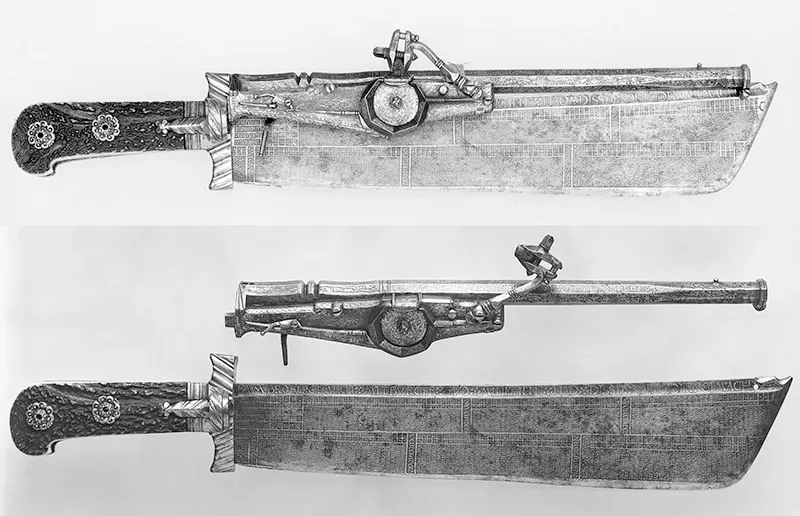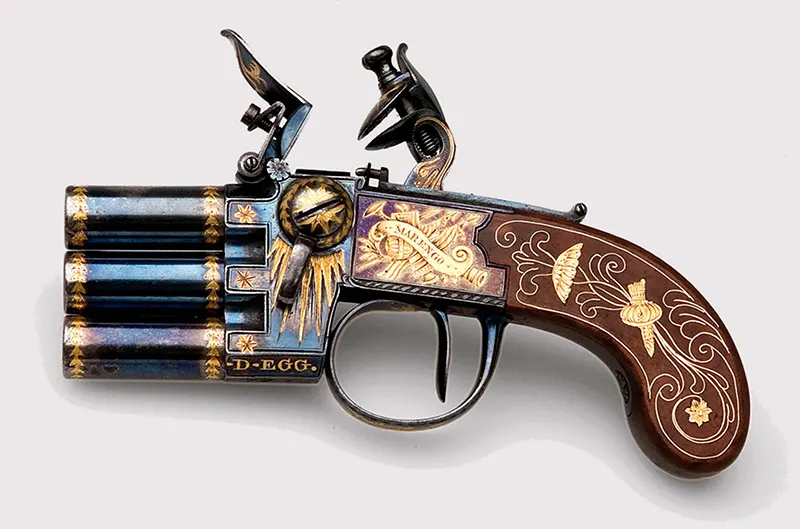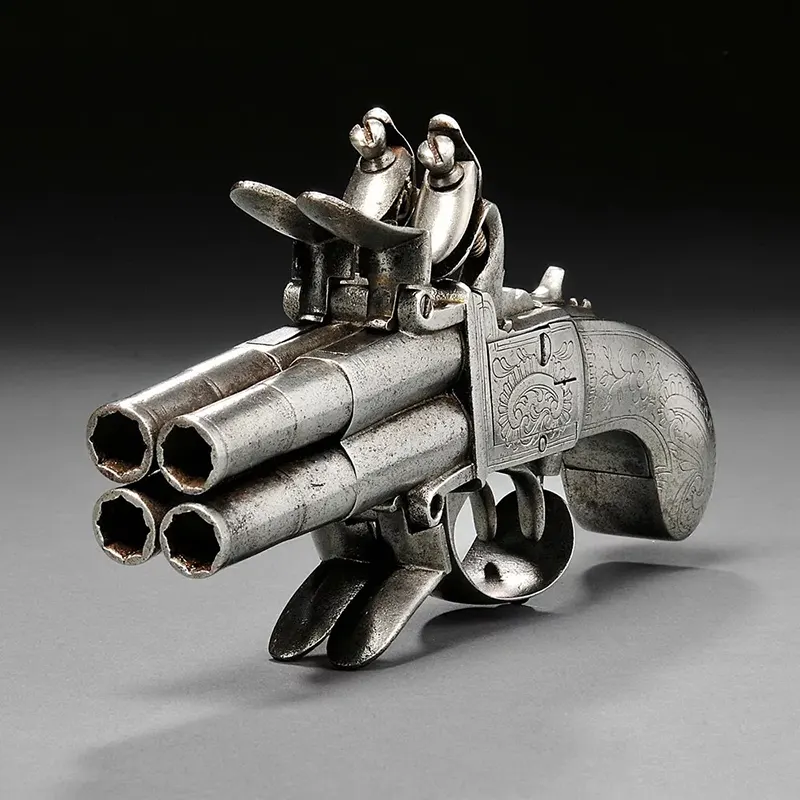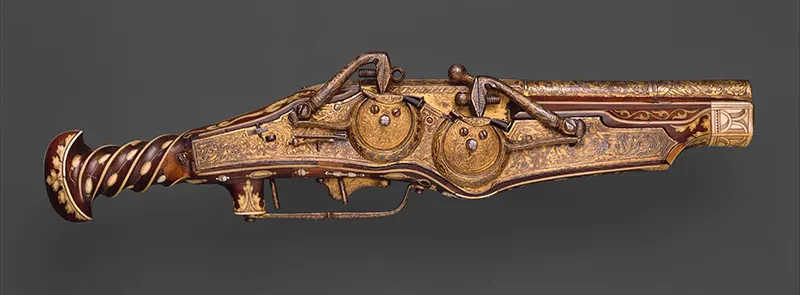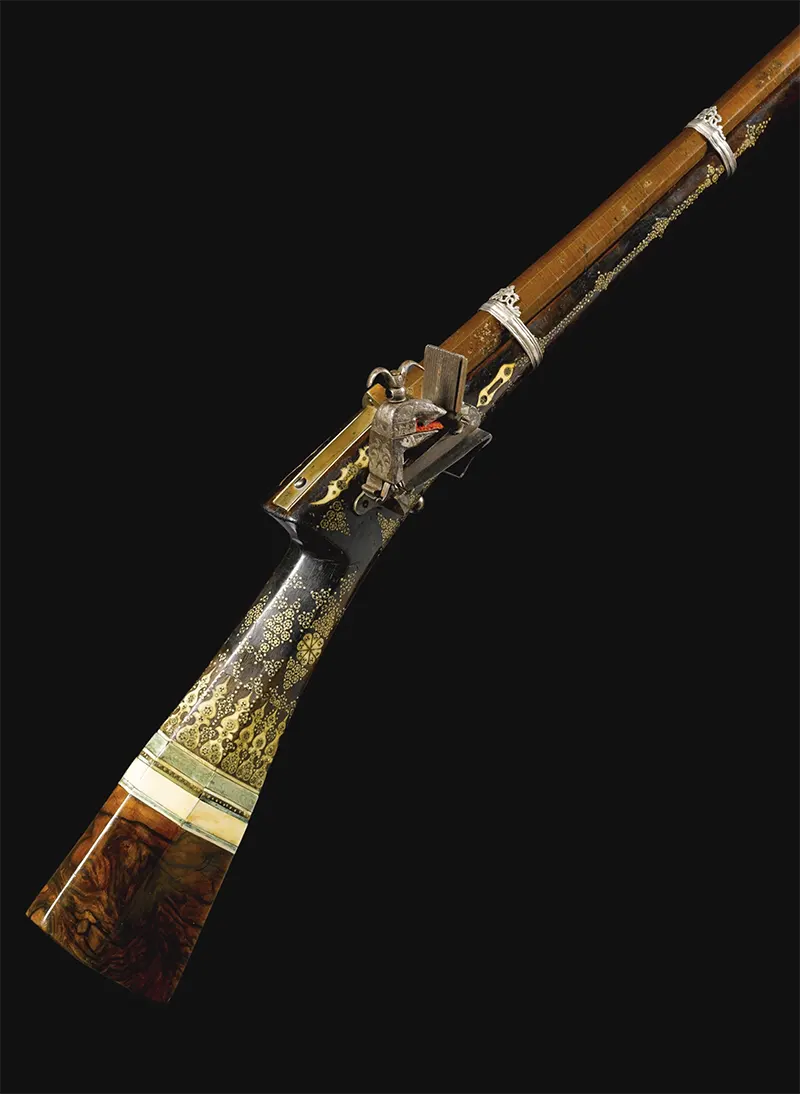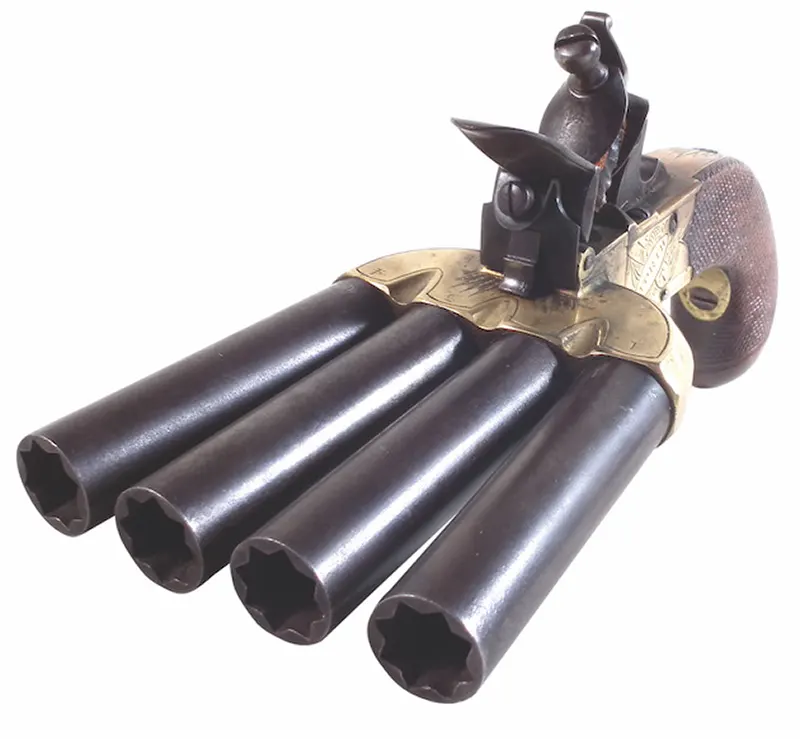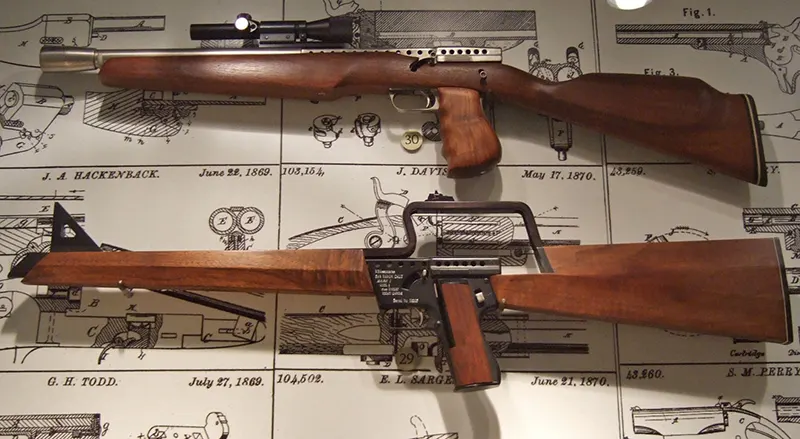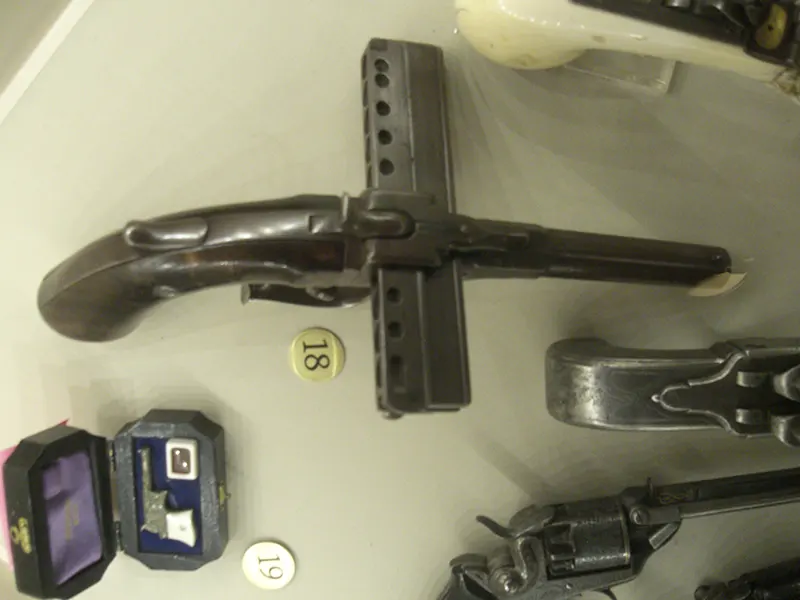Guns have played a significant role in shaping human history, from the development of early firearms in the 14th century to the modern weapons used in warfare today. Throughout this history, there have been numerous examples of guns that were not only effective at their intended purpose but also had a unique and sometimes bizarre appearance. From antique firearms adorned with intricate engravings and elaborate designs to the futuristic guns of science fiction, the world of guns has always been a blend of both elegance and eccentricity. In this article, we will explore some of the most classy and bizarre guns in history. We will examine the stories behind their creation, their unique features, and the historical context in which they were used.
Whitney Wolverine: The Atomic Age Pistol (1956)
The Whitney Wolverine is a semi-automatic .22 LR caliber pistol created in 1956. Notable for its advanced, “space-aged” looks and then-new aluminum construction, it has a 10-round magazine, a barrel 4.625 inches (117.5 mm) long, and a weight of only 23 ounces (650 g). The Wolverine was engineered by Robert Hillberg, who learned about aluminum casting during WWII while working with aircraft guns and later became research engineer for High Standard Manufacturing Company. Only 13,371 of these .22 semi automatic pistols were made in its short period of production between 1956 and 1958. The plastic grips came in either a black, dark brown or white; the white grips are found mostly on the nickel-plated models. Its name, Wolverine, was after Hillberg’s favorite football team, the University of Michigan Wolverines. The Whitney name was used because the factory was located near the old Eli Whitney factory site. A victim of extremely poor marketing in the beginning, financial problems and then being under priced by $2.00 by both Ruger and Colt with their new semi-automatics .22, the company was doomed. The original retail price was $39.95 blue and $44.95 nickel-plated (equivalent to $398 and $448 now).
German hunting knife that’s also a gun and a calendar (1528)
This is a German hunting knife that’s also a gun and etched with a calendar for the years 1529–34; barrel dated 1540 or 1546. Etcher by Ambrosius Gemlich. Inscribed: Ambrosi Gemlich Mitbvrger zvo Minichenn had disse Kollender gemach. In the sixteenth century, wheellock pistols sometimes were combined with swords, knives, axes, maces, spears, and even crossbows, which could be used in the event the pistol misfired. Usually clumsy and impractical, combined weapons were nevertheless highly prized curiosities. In this example (above), the heavy, cleaverlike blade is etched with a calendar and the decorator’s name.
Napoleon’s three-chamber box lock pistol (1802)
A historic gold-inlaid 120-bore three-barrelled flintlock box-lock tap-action pocket pistol presented in 1802 by Lieutenant-Colonel Thomas Thornton to Napoleon Bonaparte as First Consul. Interesting to note the pistol is made by a London gunsmith Durs Egg, circa 1800 With blued turn-off barrels each inlaid with an engraved gold foliate band around the muzzle and breech, and numbered from ‘1’ to ‘3’, the top barrel in gold, blued border engraved breech-block signed in gold beneath and inlaid with three engraved gold stars and a gold starburst on each side. The lowest barrel has been fired more often.
A knuckleduster/revolver (1870)
The Apache operates on the principle of a pepperbox revolver using a pinfire cartridge and incorporates a fold-over knuckle duster forming the grip and a rudimentary foldout dual-edged knife. Due to the lack of a barrel, the revolver’s effective range is very limited. Since its component parts can be folded inward towards the cylinder, it is easily concealable inside a pocket. It was common to leave an empty chamber with no cartridge under the hammer, as the weapon has no trigger guard or safety catch. Despite its limited potential, the revolver was effective at extremely close range. For reloading, the cartridge cylinder must be removed, refilled, and replaced.
Makarov pistol, a birthday gift to Josef Stalin (1949)
In 1949, Joseph Stalin received a Makarov 9x18mm semi-auto pistol as a birthday gift. Designed by Nikolay Fyodorovich Makarov, the government selected the pistol that year for further development and mass production. By 1951, it had become the Soviet Union’s standard military and police sidearm. The gift came from gunsmiths in Tula, a Russian city south of Moscow. The words “To Joseph Vissarionovich Stalin, for 70th Birthday, from Tula Gunmakers” were engraved on the barrel.
Continental Four-barrel Flintlock Pistol (18th century)
Continental Four-barrel Flintlock Pistol, c. late 18th century, iron butt and frame engraved with foliate designs, four rifled barrels, two hammers, and four steels, overall length 7 inches.
Double-Barreled Wheellock Pistol Made for Emperor Charles (1540)
One of the earliest pistols, this firearm was designed and produced by Peter Peck, a maker of watches and guns. The two locks combined in one mechanism provided the barrels with separate ignition. Made for Emperor Charles V (reigned 1519–56), the pistol is decorated with his dynastic and personal emblems: the double-headed eagle and the pillars of Hercules with the Latin motto PLUS ULTRA (More beyond).
Wheellock pistol made for Maximilian I of Bavaria (1600)
This German wheellock pistol was steel-chiseled by Emanuel Sadeler circa 1600–1610. An all-steel stock is unusual and was probably used to give Sadeler more surface on which to display his talents. The pommel is decorated with the coat of arms of Bavaria under a ducal crown and encircled by the collar of the Order of the Golden Fleece. Duke Maximilian I (1573–1651) became a knight of this prestigious order in 1600.
A multiple-barrel firearm (1800s)
This type of firearm was popular in North America from 1830 until the American Civil War, but the concept was introduced much earlier. In the 15th century, Ribauldequin, a version of the Volley gun, had several single shot barrels were attached to a stock, being fired individually by means of a match. Around 1790, pepperboxes were built on the basis of flintlock systems, notably by Nock in England and “Segallas” in Belgium. These weapons building on the success of the earlier two barrel turnover pistols, were fitted with three, four or seven barrels. These early pepperboxes were hand rotated. The invention of the percussion cap building on the percussion powder innovations of the Rev. Alexander Forsyth’s patent of 1807 (which ran until 1821), and the industrial revolution allowed pepperbox revolvers to be mass-produced, making them more affordable than the early handmade guns previously only seen in the hands of the rich.
Ottoman ivory-inlaid miquelet rifle
The gun has an octagonal barrel made of watered-steel that is stained. It has a raised sighting plate which is clasped by three pierced silver capuchines to the horn-tipped forestock. The lock is decorated with inlaid-silver floral designs. The stock is six-sided and has panels and rosettes made of stained and natural ivory with extensive brass studding.
Elgin cutlass pistol (1837)
A pistol sword is a sword with a pistol or revolver attached, usually alongside the blade. It differs from a rifle with a bayonet in that the weapon is designed primarily for use as a sword, and the firearm component is typically considered a secondary weapon designed to be an addition to the blade, rather than the sword being a secondary addition to the pistol. In addition, the two components of these weapons typically cannot be separated, unlike most bayonet-fixed rifles. Historically, some flintlock pistols of the 17th and 18th centuries were constructed as gun-swords, with the barrel of the pistol attached to the side of the blade of a shortsword or dagger. A shell guard protected the firing mechanism when it was used as a sword. These were used by French and German hunters to kill wounded wild boar.
The Krummlauf Assault Rifle (1940s)
Krummlauf means “curved barrel,” and refers to a barrel-and-periscopic-sight combination with a 30-degree bend that could be fitted to a standard Sturmgewehr 44 assault rifle. It allowed this bizarre gun to shoot around corners without exposing the shooter, and was intended for tank crews. The bent barrel attachments had very short lifespans—approximately 300 rounds for the 30° version, and 160 rounds for the 45° variant—as the barrel and bullets fired were put under great stress. Another problem besides the short life-span was that the bending caused the bullets to shatter and exit the barrel in multiple fragments, producing an unintended shotgun effect. The Krummlauf in a Maschinenpistole Vorsatz (P) mount was developed as an alternative close defense weapon for tank destroyers. This mount was fitted to a roof hatch in many Panzer IV/70 (A) vehicles. The tank crew could then attach a StG 44 and use this as a close defense machine gun.
The Velo Dog Revolver (19th century)
In late 19th century France, the bicycle, or velocipede as it was then called, came much in fashion, and dogs discovered that it was great sport chasing after peddlers and biting at their legs, or trousers. The answer to the problem was the Velo Dog revolver. The invention of one Rene Galand, was a small double-action pocket revolver with a shrouded hammer and, in later models, a long, guardless trigger. Dog plinking became so popular that Velo Dog revolvers were produced in varying configurations.
The Duck Foot Pistol (18th century)
This bizarre-looking firearm was given its name because the way that the barrels were mounted reminded people of a duck’s webbed foot. T he barrels were splayed out in a fan shape of about 60 degrees, to give its bullets a spread in the hope that they would hit multiple targets. It was a close-range anti-personnel weapon that was at its most effective when used against a crowd in a confined space.
Gyrojet guns (1960s)
The Gyrojet is a family of unique firearms developed in the 1960s named for the method of gyroscopically stabilizing its projectiles. Rather than inert bullets, Gyrojets fire small rockets called Microjets which have little recoil and do not require a heavy barrel or chamber to resist the pressure of the combustion gasses. Velocity on leaving the tube was very low, but increased to around 1,250 feet per second (380 m/s) at 30 feet (9.1 m). The result is a very lightweight and transportable weapon. Long out of production, today they are a coveted collector’s item with prices for even the most common model ranging above $1,000. They are rarely fired; ammunition, when available at all, can cost over $100 per round.
Borchardt C-93 Pistol (1893)
The Borchardt C93 is a semi-automatic pistol designed by Hugo Borchardt in 1893. The design is based upon the Maxim gun’s toggle lock model. Borchardt developed the high-velocity, bottlenecked 7.65×25mm Borchardt cartridge for the C93. His assistant at the time, Georg Luger, also claimed to have influenced its design. Machine tool manufacturer Ludwig Loewe & Company of Berlin, Germany, produced the C93 in anticipation of military orders. With about 1,100 manufactured by Loewe and nearly 2,000 more produced by Deutsche Waffen- und Munitionsfabriken (DWM). The Borchardt C93 was the first mass-produced semi-automatic pistol. Although it was accurate and its rate of fire was rapid, the Borchardt pistol was expensive to produce and unwieldy to handle due to its almost vertical grip and distribution of weight. Its extended grip made aiming and firing difficult and gave it uneven weight distribution. One of the manufacturers wanted to redesign the pistol, but Borchardt turned down the offer because he believed the gun was perfect. The manufacturer later bypassed Borchardt and met with his assistant, Georg Luger, who invented the Luger pistol that was used by Germany in World War I and in World War II as well.
Kolibri 2 mm Pistol (1910)
The 2mm Kolibri was the smallest commercially available centerfire cartridge, patented in 1910 and introduced in 1914 by Franz Pfannl, an Austrian watchmaker, with financial support from Georg Grabner. It was designed to accompany the Kolibri semi-auto pistol or single-shot pistol, both marketed as self-defense weapons. The name is derived from Kolibri, the German word for hummingbird, which is among the smallest of birds. Due to the weakness and inaccuracy of the firearm, the 2mm Kolibri was advertised as a ladies’ self-defense weapon that was small enough to fit inside a handbag. While probably not effective against a mugger if shot at the chest or limbs, it could potentially inflict some damage if shot at the attacker’s face. It was discontinued in 1914 with the outbreak of the war.
Harmonica Gun (18th century)
A harmonica gun or slide gun is a form of firearm which was breech loaded with a steel slide, containing a number of chambers bored in it and which were filled with projectiles. Most harmonica guns are percussion cap guns, although some designs exist for compressed air guns and some examples were made in pinfire cartridge form. In percussion cap guns, each chamber contains a separate primer, powder charge, and projectile. The slide was inserted in an opening in the breech action and could be advanced by releasing the camlock, moving the slide by hand. The gun comes in both pistol and rifle models, as well as single-action and double-action. The earliest example of a harmonica gun is probably the one constructed by the Swiss inventor Welten in 1742. (Photo credit: Wikimedia Commons / Pinterest / Flickr). Notify me of new posts by email.
Δ Subscribe



